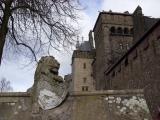
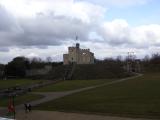
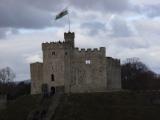
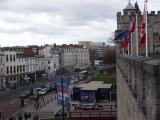
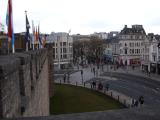
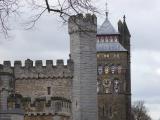
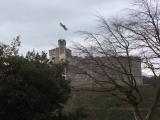
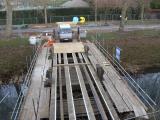
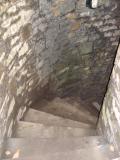
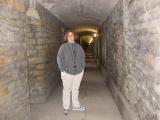
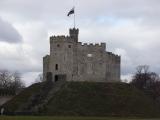
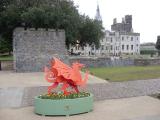
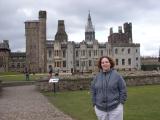
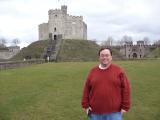
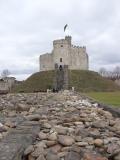
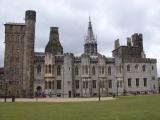
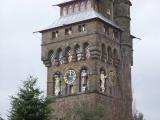
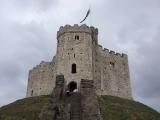
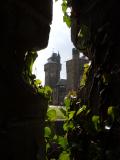
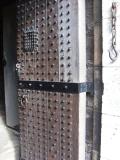
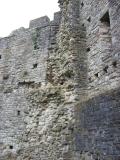
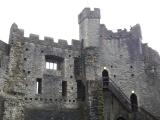
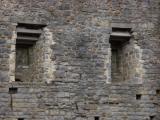
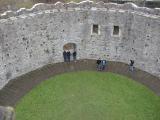
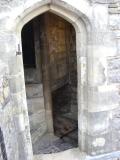
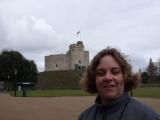
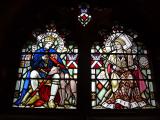
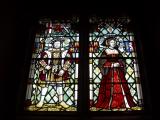
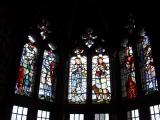
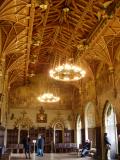
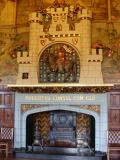
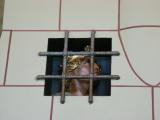
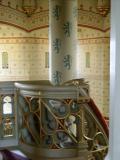
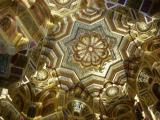
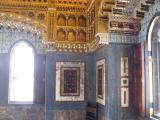
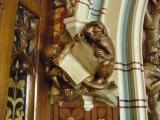
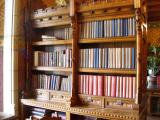
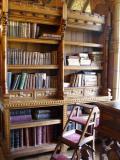
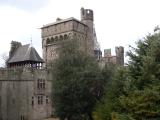
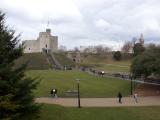
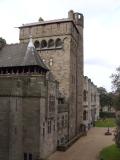
Jen and I spent a day visiting Cardiff, the capital city of Wales, in March, 2010. We spent the morning exploring Cardiff Castle, had a nice lunch in downtown Cardiff, and then spent the afternoon at the National Museum of Wales. I really enjoyed our day in Cardiff, despite the cold and rain. Everyone was friendly, and it was a change of pace from our trip in England.
These photos are copyright © 2010 Kenneth E. Harker. All rights reserved.
Cardiff Castle is a medieval castle that was built on the site of an old Roman fortress close to the estuary of the River Severn. The oldest surviving portion of the castle was built in 1091 by Robert Fitzhamon, lord of Gloucester and conqueror of Glamorgan (the region of southeastern Wales in which Cardiff is located). During the early 19th century, extensive renovations of the castle tore down walls and introduced Gothic revival architecture to the castle apartments. The castle walls were restored in the early 20th century. Given as a gift to the city of Cardiff by the 5th Marquess of Bute in 1947, the castle is today a major attraction in the city center.
 |
The castle walls as seen from Castle Street. As it was still early in the season, the trees did not yet have their spring leaves. |
 |
The Norman keep at the center of the castle is the oldest surviving structure. It was built around the year 1097 by Robert Fitzhamon, lord of Gloucester and conqueror of Glamorgan. The keep in Cardiff Castle is set atop a motte, a man-made hill. The construction cranes in the background were north of the castle. |
 |
The keep is the central tower at the heart of a castle, and the last line of defense from attackers. As it is the most defensible part of the castle, keeps were also used for housing prisoners. One famous political prisoner who died during detention in Cardiff Castle was Robert Curthose, the second Duke of Normandy (1054-1134), who led an unsuccessful revolt against his father, William the Conqueror (1028-1087). |
 |
Castle Road, as seen from atop the castle wall. The building on the near side of the road was the ticket office and a gift shop. The flags of a variety of nations were flying from the castle walls. |
 |
Downtown Cardiff, as seen from the castle walls. Despite being cold and overcast, there were a lot of locals and tourists out for the day. |
 |
The Clock Tower was a 19th century addition to the castle. |
 |
The Norman Keep, as seen from the top of the eastern castle wall. |
 |
The North Gate Bridge crosses a creek that flows along the outside of the north wall, and was being reconstructed. Pac-Man and Inky were walking down the street at the time. |
 |
A spiral staircase leading down into the tunnels inside the castle walls. |
 |
Jen, inside the castle walls at Cardiff Castle. These tunnels were used as air raid shelters for the nearby city residents during the Second World War. |
 |
The Norman Keep. |
 |
A Welsh dragon sculpture near the visitor center inside the main gate of the castle. The red Welsh dragon (Y Ddraig Goch) is the national symbol of Wales. The red dragon supposedly represented the Welsh in their successful struggle to remain independent of the invading Saxons, represented in the local mythology by a white dragon. The Welsh would later be conquered by the Normans, but by then the red dragon was already associated with Wales. |
 |
The mansion inside the castle was extensively altered by the 3rd Marquess of Bute in the late 19th century. The Marquess was one of the wealthiest men in Britain, and re-made the mansion into a medieval fantasy of Gothic revivalist architecture. |
 |
Ken, with the Norman Keep in the background. The large lawn inside the castle is the result of renovations done by the Bute family in the 19th century. Interior walls and buildings were torn down in order to open up the space for gardens (since removed) and a green. |
 |
These stones mark the original foundation of a stone wall that bisected the interior of the castle. The portions of the castle to the left would have been the most private portions, reserved for the castle owners' family. The portions of the castle to the right were for business offices and included a portion that was even opened to the public on occasion. |
 |
The Apartments, as they are called, are really a large, luxurious mansion on the western side of the castle. |
 |
The Clock Tower. |
 |
The staircase up to the keep was quite steep. |
 |
The Clock Tower, as seen through a loophole in the staircase walls leading up to the keep. |
 |
The very heavy, iron-studded door to the Norman Keep. |
 |
The walls on the inside of the keep had a lot of holes in them. These holes would have been used to support timber beams for wooden buildings inside the stone walls. |
 |
More of the Norman Keep's interior walls. The staircase is a modern addition, leading up to some rooms near the top of the keep. |
 |
A close up view of some of the holes where wooden beams would have been supported. |
 |
The inside of the Norman Keep, as seen from the top of the walls. |
 |
Spiral staircases inside the walls of the Norman Keep. |
 |
Jen, with the Norman Keep in the background. We had some brief showers while visiting the castle, and it was overcast all day long. |
 |
This stained glass window featured George Plantagenent, Duke of Clarence (1449-1478) and his wife Isabella Neville (1451-1476). George was the brother of Kind Edward IV, but alternately supported both sides in the War of the Roses. He would eventually be found guilty of treason and was executed in the Tower of London. According to legend, he was drowned in a butt (close to 475 liters) of Malmsey wine, an ironic tribute to his famous alcoholism. Isabella died shortly after the birth of her second child. |
 |
Stained glass windows inside the mansion. This was King Henry VIII (1491-1547) and his third wife, Jane Seymour (1508-1537). King Henry VIII was responsible for the Church of England splitting from the Roman Catholic Church, and oversaw the legal union of England and Wales beginning in 1535. Jane Seymour would die due to complications of childbirth after the delivery of her son Edward (1537-1553), who was crowned Edward VI in 1547 at age 9. |
 |
More Stained glass windows. |
 | The ballroom inside the mansion. Flash photography was not allowed inside. I did the best I could without a flash. |
 |
The fireplace in the ballroom. |
 |
A bust of a prisoner behind bars is a detail at the base of the castle sculpture above the fireplace. |  |
Ornate columns and wallpapers in the staircases. |
 |
Details on the ceiling in one of the rooms. |
 |
This room was decorated in an "Arabic" style. |
 |
Some monkeys fighting over a book decorate the entranceway to the library. |
 |
Some of the built-in bookcases in the library. |
 |
Many of the books in the library were bound records of Cardiff city council business and politics. |
 |
More castle buildings. |
 |
Another view of the castle. |
 |
Castle walls and buildings. |
Cardiff (Caerdydd in Welsh) is the capital city of Wales. Located at a harbor where the River Taff drains into the estuary of the River Severn, it is also the largest city in Wales, with about 1/3 of the total Welsh population. The city was founded around a Roman fort established during the Roman conquest of Wales in the year 75 AD, which displaced a native settlement at the site that dated to at least the year 50 BC. Cardiff was only declared the capital city of Wales in 1955. We explored downtown Cardiff and visited the National Museum of Wales.
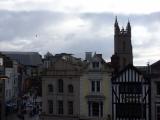 |
The city of Cardiff, including Llandaff Cathedral. Llandaff Cathedral is the seat of the Bishop of Llandaff, the head of the Anglican Church in Wales. |
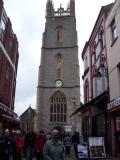 |
Llandaff Cathedral, in the rain. Parts of the cathedral date to construction that began in 1107, during the reign of the Norman kings. This bell tower was added to the church in the 15th century. |
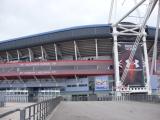 |
The Millennium Stadium in downtown Cardiff. Among other uses, this stadium is the home field of the Welsh national rugby union team. The stadium was built in 1999 as part of the United Kingdom's millennial celebrations. It hosted several games in the 1999 Rugby World Cup including the final match where Australia beat France 35-12. The stadium also hosted matches in the 2007 Rugby World Cup. It has a capacity of 75,000 spectators. |
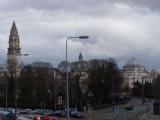 |
Northeast of Cardiff Castle is the Cardiff City Hall with its clock tower and the National Museum of Wales, with its large dome roof. |
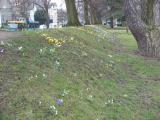 |
Some flowers in the park across the street from the National Museum hint that springtime is near. |
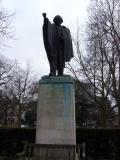 |
A statue of David Lloyd George (1863-1945). George was the first and so far only Welshman to serve as Prime Minister of the United Kingdom (1916-1922). He is remembered both for his service as Prime Minister during the First World War, and for his role in expanding the modern welfare state in the United Kingdom. |
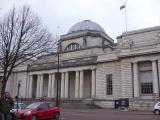 |
The National Museum of Wales is just down the street from Cardiff Castle. Most of the museum was on two levels, with history on the ground floor and art on the upper level. Although some of the history exhibits were on natural history, the most interesting ones were those that focused on the local history of Wales. On the upper level, the sculpture exhibits were under renovation, but the painting galleries were excellent. |
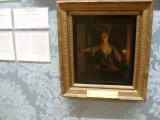 |
My favorite painting in the art galleries of the National Museum was "The Girl at the Shutter" by Godfried Schalcken, a 17th century Dutch painter. This photo of it is pretty terrible, but it was the best I could do without a flash. I later learned that Schalcken specialized in portraits and small scenes in candlelight. |
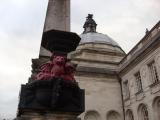 |
A Welsh red dragon on a wall at Cardiff City Hall. |
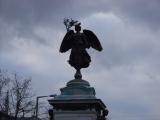 |
An angel on top of Cardiff City Hall. |
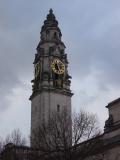 |
The clock tower at Cardiff City Hall. |
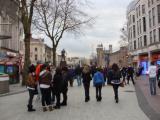 |
Queen Street in downtown Cardiff is a pedestrian-only mall and was full of people on Saturday afternoon. |
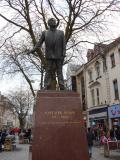 |
A statue of Aneurin Bevan (1897-1960) on Queen Street. Bevan was the Minister of Health when Great Britain created the National Health Service in 1946. Apparently, a lot of the politicians that led the drive for Britain to become a welfare state were from Cardiff. I don't quite understand the pose chosen for this statue. |
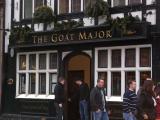 |
A public house in downtown Cardiff. The "Goat Major" is the soldier charged with looking after Taffy, the goat mascot of the Royal Regiment of Wales, an infantry regiment in the British Army. Despite the title, the "Goat Major" is actually a Corporal. |
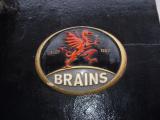 |
The beer of choice for zombies everywhere. |
| Last Updated 1 August 2018 |